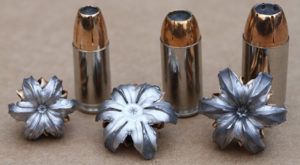I used to be a big revolver fan. I had fallen into the “snub-nosed revolvers are best for women” trap. I loved my NAA peashooter and thought for a carry gun, a .38 double-action would be a natural fit. Turns out, after not doing as much research as I should have, I had buyer’s remorse after jumping the gun…so to speak.
For concealed carry and home defense, the revolver certainly has a few significant benefits. One, their reliability. A revolver operates every single time you pull the trigger and generally won’t malfunction, i.e. jam. They are also easy to use, especially the hammerless kind. Ease of use is really important when it comes to shooting under duress. Revolvers are a solid choice for some.
I thought a revolver was going to be a solid choice for me, too. Turns out, a semiauto is my preferred choice.
Years ago, I spent a pretty penny on a snub-nosed .38 Special with integrated laser. It was a very good gun, lightweight, subcompact, with a better trigger pull than many other revolvers. Practicing with it, though, was a beating…literally. One box of ammo and there were painful blisters on the web of my hand. Recoil from those snubbies is no joke and if you are recoil sensitive, I don’t recommend choosing one as your protection piece. If you don’t enjoy shooting your gun, you aren’t going to shoot it and I’m a huge proponent of regular training. So, pick something you have fun with and like to shoot.
I’m still a revolver fan—who am I kidding, I’m an all-gun fan—but I no longer feel it is the best firearm for me.
Choosing a home defense or protection gun is a big deal. I mean, it literally might save you and your loved one’s lives. Unlike careers and colleges, there might not be any second chances. Take this seriously and pick the right one.

With so many choices, how do you do that?
By the process of elimination and plenty of range time.
Before heading out on your search, lets narrow the playing field. This will cut costs down on ammo and range fees, not to mention wasted time, when you go to rent the guns that have piqued your interest.
We will discuss:
- Type of firearm
- Caliber
- Fit and feel
- Budget
Type of Firearm
Any firearm technically has the capacity to stop a threat, yet certain firearms are better suited for certain jobs than others. Like, you don’t really want to use a lever-action .30-30 for the bad guy breaking into the bedroom if you have something else. Guns popular for home defense are shotguns, handguns (revolvers and pistols,) and AR-15 rifles. There are pros and cons of the use of each.
- Handgun—revolver and semiauto pistol
- Shotgun—pump, single-shot, side by side, over/under, semiautomatic
- Rifle—SBR, black rifle/AR/MSR, pistol caliber carbine
Revolver

Okay, so it’s a total myth that revolvers won’t jam, but it is highly unlikely, especially if well maintained. It is true that they are easy to learn how to shoot and are super reliable.
Pros:
- Reliable
- Less likely to malfunction
- Easy to operate
Cons:
- Holds few rounds
- Must practice extensively to reload quickly
- Must practice trigger control
- Need to upgrade sights
- Recoil mitigation may be problematic for some
Semiautomatic

Semiautomatic pistols—especially full-sized, offer a full grip, a longer line of sight for more accurate aiming, extended magazines, often don’t produce as much perceived recoil and have the capability of adding a variety of sights like red dot/reflex, lasers or tritium night sights that help increase your target acquisition in the dark.
Pros:
- Holds more rounds
- Comfortable shooting
- Easy to upgrade to night sights/mini red dot sight
Cons:
- Can malfunction
- Needs training with safety
- May be difficult to operate for some with disabilities or injuries
Shotgun
Despite what you’ve heard, the racking of a shotgun won’t necessarily send a bad guy running and yes, you do, in fact, have to aim a shotgun.

Pros:
- Easier to aim when stressed
- More likely to hit your target to stop a threat
Cons:
- Unwieldy in tight spaces
Rifle

Easily one of the most versatile firearms, Modern Sporting Rifles, like ARs, are extremely adaptable to fit the shooter perfectly. From lightweight accessories to stabilizing braces, you’ll be able to build an AR that helps you shoot like an expert.
Pros:
- Easy to operate
- Proven round for self-defense
- Recoil is manageable for beginners, youth and women
- Customizable
- Easy to adapt for those with disabilities
Cons:
- May be hard to maneuver in tight spaces
- Need right ammo for home defense
Caliber
Okay. So. I am not here to get into an argument or tell you I’m right and you’re wrong. I’m not a caliber absolutist or snob. I subscribe to the philosophy that I’d rather you carry ANYTHING than nothing, so, if .22 LR is all you can handle, then .22 LR it is.
I will tell you this though—self-defense handgun experts and the FBI agree; you shouldn’t use any caliber smaller than a 9mm for self-defense—including the very popular .380 ACP.

“Acceptable” self-defense calibers according to FBI ballistics testing are .40 S&W, .45 ACP, 10mm, .357 Magnum, .357 Sig, 12 gauge, .223 Remington/5.56mm and 5.7×28. This is of course, not an all-inclusive list. Surely if .44 Magnum can take down a bear, it will take down a two-legged predator, as well.
Like gun “quality,” the “correct” caliber is hotly debated, so I’m not going to try to tell you which one is best. I’ll let you do your research and decide for yourself.
(With that being said, I will let you know, I carry a semiauto .380 ACP and my primary home defense gun is a .223 AR with a .22 Magnum back-up S&W revolver.)
Fit and Feel
As odd as this may sound, a firearm can be ill-fitting. With my small hands, larger guns can make it difficult for me to manipulate a thumb safety in one fluid movement. Some guns can be too big, some too small. The way the gun fits you can affect your trigger control, how well you recover from recoil and how well you can safely operate the firearm. In other words, a bad fit can make you a bad shot.
You want a gun where you can easily reach the controls, your finger rests properly on the trigger and the grip angle feels secure and comfortable.
Are you placing your finger wrong on the trigger? Click here to make sure you are manipulating the trigger properly.
Budget
How much should you spend on a gun?

From low end to high end and everything in between, fortunately, there is a good gun for every budget.
Now, I will tell you this, you and your family’s lives are priceless and so if it takes some saving and sacrifice, it is worth it to get the best firearm you can afford—GLOCK, Kimber, SIG Sauer, H&K, FNH—these are gun manufacturers with a solid reputation for a reason.
Before getting your undergarments in a twist, there are top quality firearms that are also extremely affordable. For example, you can pick up a Mossberg 500 (allegedly the only shotgun to have passed the U.S. Army’s MIL-SPEC 3443E test) for less than $350 and it’s Maverick 88 counterpart for less than $200! I know people who even swear by their intensively taunted Hi-Point. (YEET!)
There are cheap guns you can trust. Decide how much you want to spend and use that as a basis to narrow your choices in the category of gun you want.
After going through this checklist of how to pick out a gun, your list should be narrowed down to a few that meet your requirements. Go to your local range that rents guns and try them out. The one that feels most comfortable, is easy to operate and the one that gives you few problems is the one for you!

